There are a million different reasons why you might want to grow avocados at home instead of buying them at the grocery store including the environment, humanitarian concerns, and the pure joy of eating something that you grew yourself. But, there is a lot you should know about growing an avocado from seed. There are a few different methods for starting an avocado pit and some are better than others, plus you have to consider fertilizer, the weather, and so much more. Here’s my guide on growing an avocado from seed.
The Toothpick Method of Growing an Avocado From Seed
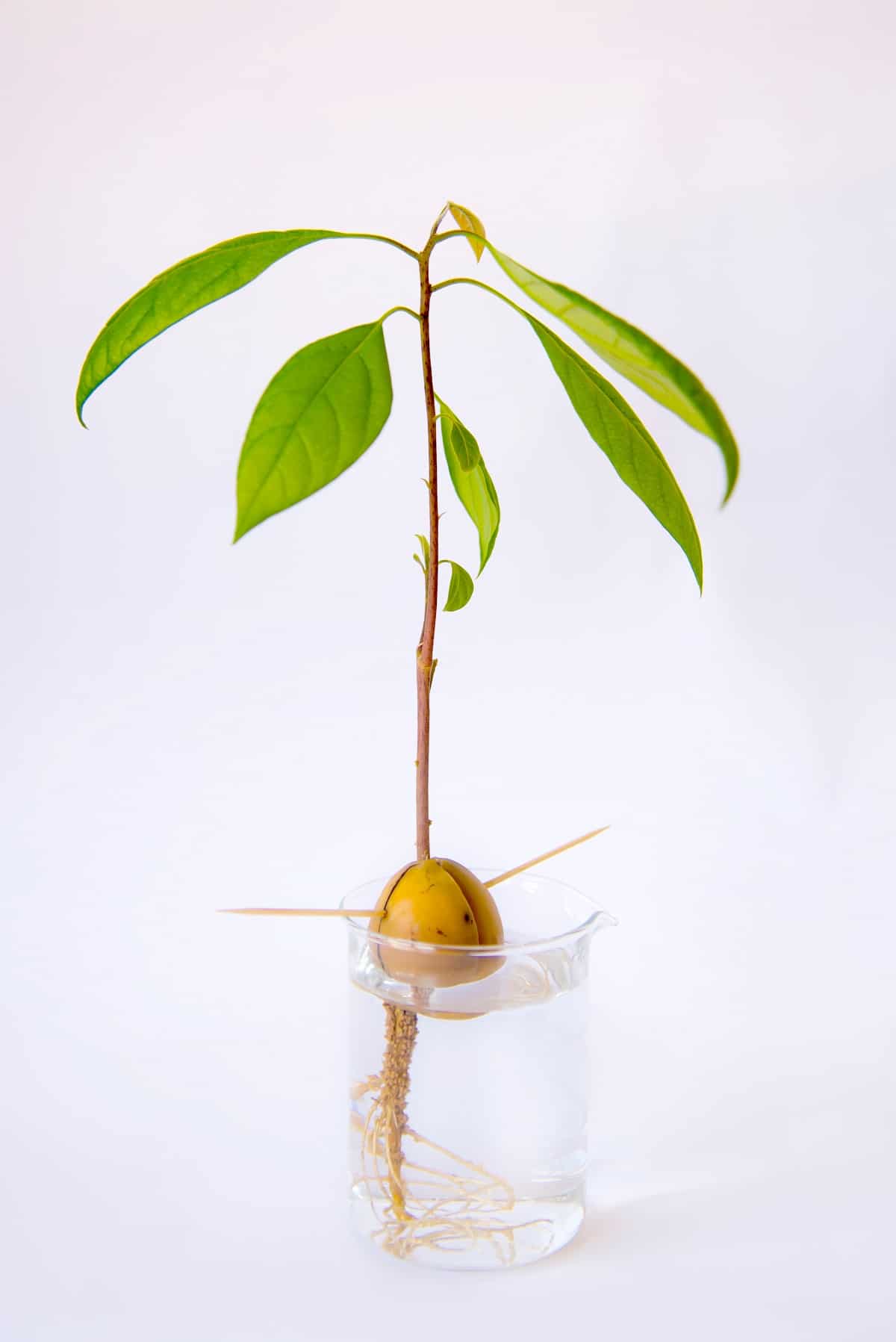
I’ve been aware of the toothpick method of growing avocados for about 30 years now. I remember being a little girl and helping my dad change the water on his avocado pits that were in the window balanced delicately in a cup of water. We did this a few times throughout my childhood and it is actually some of my earliest memories of gardening.
The idea is quite simple, take an avocado you bought at the store and eat all the delicious inside bits until all you have left is the pit, the seed of the avocado tree.
- Wash that pit off carefully to get any remaining bits of avocado off. If there are any left they will attract mold which will kill the entire seed.
- Once you’ve washed off the pit fill a small cup with water and set it down somewhere safe where it won’t get knocked over.
- Stick at least 3 toothpicks into the sides of the avocado at roughly equal distances apart. You might need 4 toothpicks to help with stability.
- Once you have the toothpicks in set the pit on top of the glass of water so the pit is hovering just barely over the top of the water.
- Then…you wait.
The idea is that the pit will sense the water below it and send out roots after a while to start soaking that water up. The water then starts the seed on its way to growing a tree. In a few weeks, when the plant is about 10 inches tall it will be ready to be transplanted into soil.
Unfortunately, the reality is nothing like this. While you absolutely can have success with the toothpick method, it is far more likely that your avocado seeds will rot long before it ever starts growing a tree. All those experiments I saw my father do as a child…we never got a single tree from them.
This is without a doubt the hardest way to grow an avocado from seed and I do not recommend anyone try it unless they want to do a fun science experiment with their kids. It is incredibly unlikely you will get anything to grow except some roots.
How to Grow Avocados in Soil
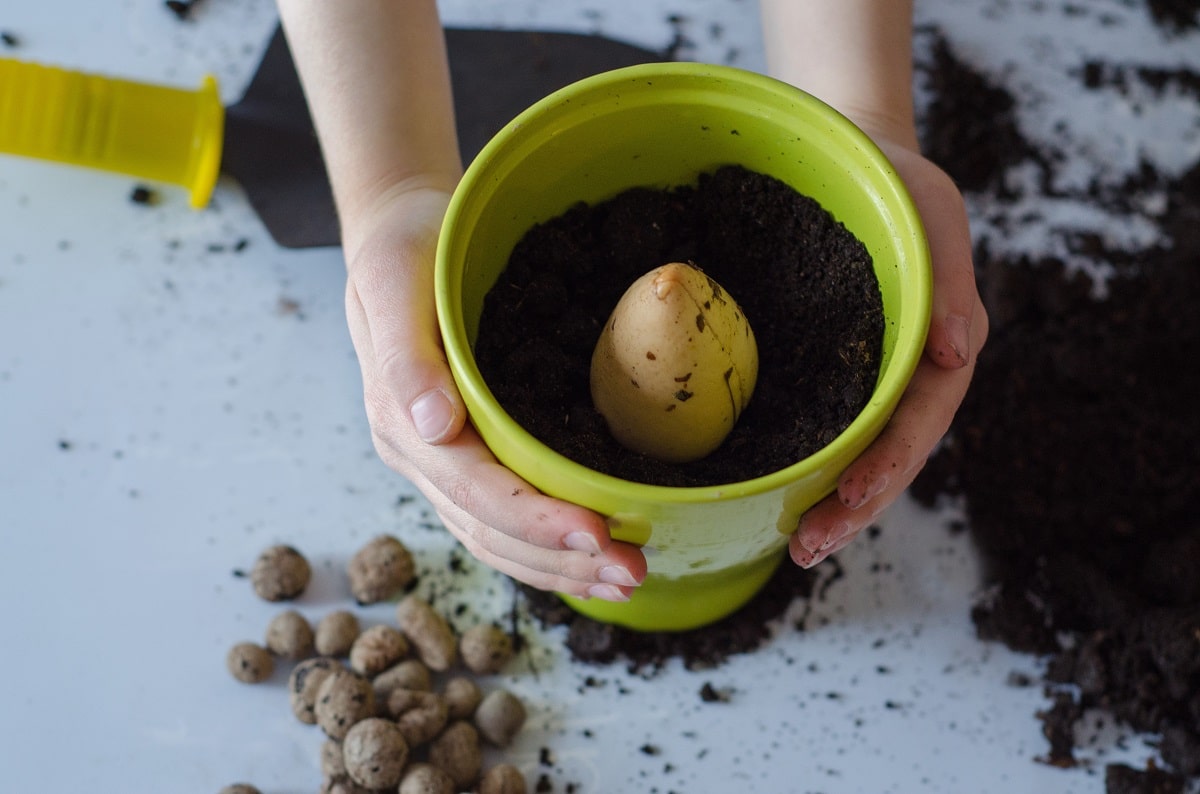
While the toothpick method is fun, there is a far more practical, and let's be honest, realistic way to grow avocados. In soil, the way they were meant to be grown.
It is best to start your avocado in a small pot that you would normally use for seedlings. This will be big enough to fit the seed and the roots that will eventually spring forth for a little while as the tree starts to grow.
- Fill your pot about three-quarters of the way full with potting soil.
- Give the soil a good watering down before you add the avocado seed.
- Put it into the middle of the pot bottom side down and give it a few twists while pressing down on it. This will lodge the seed into the dirt.
You want your seed to be about half-covered with dirt and the rest, the more pointed end sticking up out of the dirt. Keep your soil moist by watering it every few days while you look it over. The pit will crack as the little baby avocado tree pushes its way out. You might be tempted to give it a hand, but don’t. Let it happen naturally. The seed has all of the nutrients the little tree needs to grow and start making its first leaves.
Bag Germination Method for Avocados
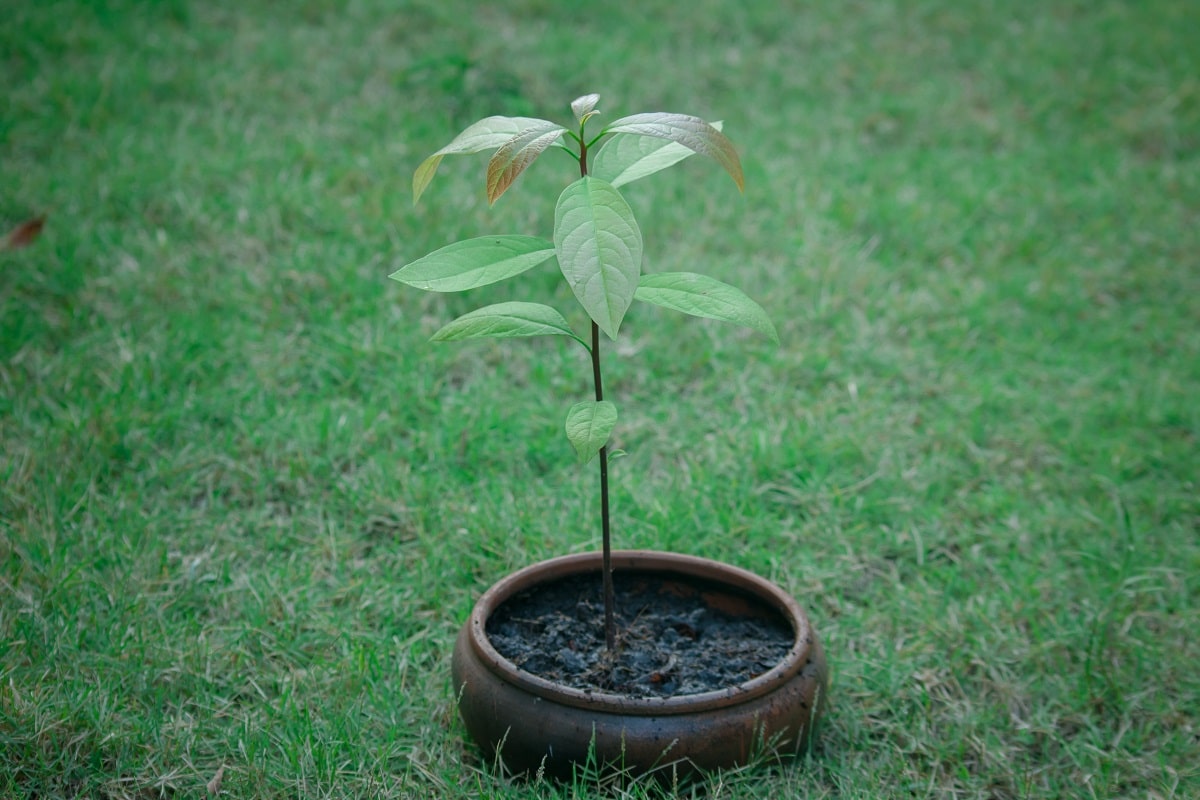
There is one final method of starting an avocado that you should know about.
Unfortunately, it doesn’t have a fancy name so we’ll just call it the bag germination method. Here’s how to do the bag germination method.
- Begin this method by letting the avocado seed dry out for a few days in a dry, dark spot.
- The brown outer skin will dry up and be very easy to peel off. I like to do it with a spoon. It makes the process go a lot more smoothly. Be sure not to damage the little disc at the bottom. It’s the most important part of the pit. Doing this will help speed up the germination process.
- Get either a small towel or a couple of layers of paper towels wet. Not so wet that it drips through.
- Put the towel inside of your Ziploc bag and lay the bag flat on its side.
- Lay the avocado pit on its side inside the bag.
- Close the bag most of the way, leaving only one or two fingers wide open for airflow.
- Put the bag somewhere dark and safe, but easily reached so you can monitor it.
One downside to this method is that it is prone to molding. So be sure to check your avocado pit at least once a day. I like to set myself a daily reminder for just after breakfast.

Which Method of Growing Avocado from Seed is Best?
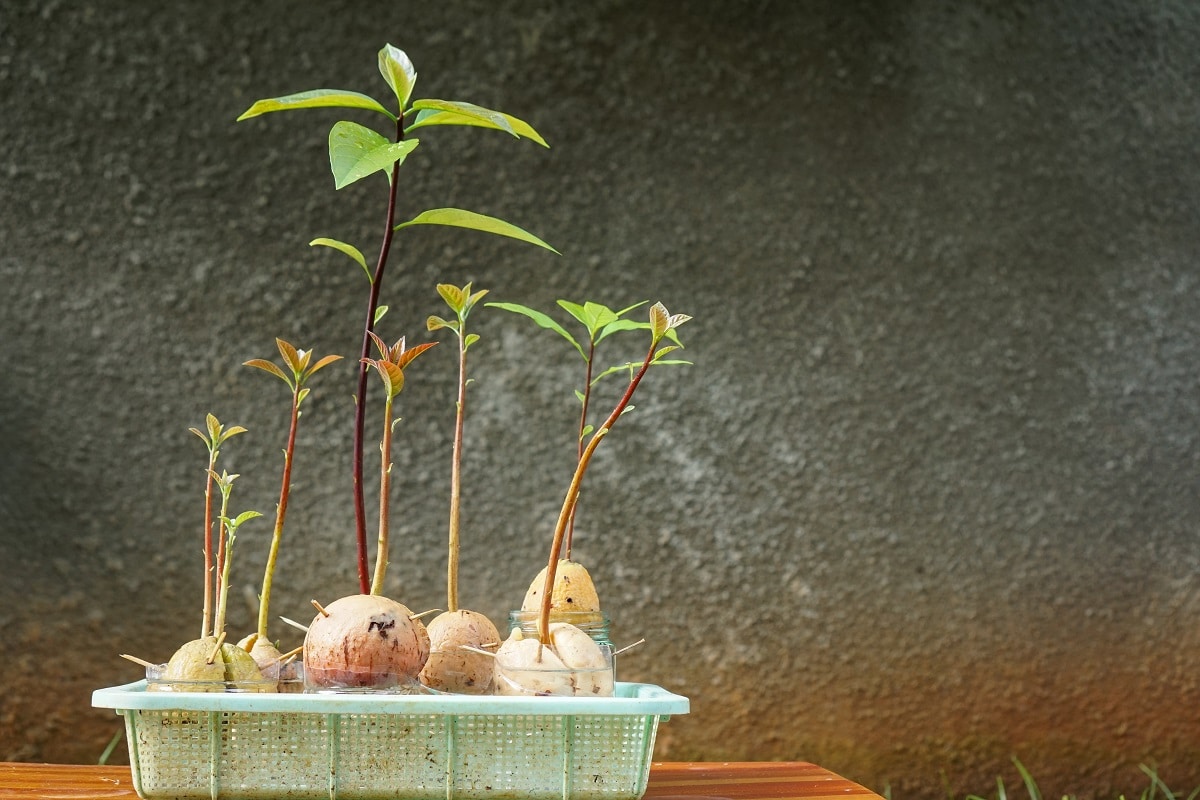
With three different methods for growing avocados, each one with its own pitfalls (no pun intended) you might be wondering which one is the best of them all.
Well, before we dive into that it might help you to frame them a different way, the toothpick method is the science experiment, the method for growing in the dirt is the way nature intended for avocados to be grown, and the bag germination is a gardener’s lifehack that actually works.
When you put it like that a winner becomes abundantly clear, the bag germination method. This method builds on what nature wants to do naturally but does it faster. It also doesn’t have the risk of root rot that the toothpick method has.
Bag germination actually works for a lot of different seeds. Though it is most commonly used to test the germination rates of seeds you have, not a method for starting seeds. This is the method I used to finally get myself some avocado trees and I know it will work for you too.
What Comes Next?
So, you’ve got your avocado seed to sprout and a little tree is growing out of it, what next?
Now, you just put it in a container full of soil and let it grow… If only it were that simple, right!?! There are a bunch of different factors you need to take into account. You can’t just get dirt from your yard and stick it in a bucket. Avocado trees have very specific temperature, soil, water, and sun requirements that you need to take into account.
Ideal Temperature for Growing Avocados
Avocados originally come from South-Central Mexico, which means that they are a tropical plant. If the temperature is likely to drop below 50 degrees Fahrenheit or 10 degrees Celsius that they are not suited for growing directly in the ground outside.
So, unless you live in Southern Florida or around San Diego, you are going to have to grow your tree indoors in a container. The good news is that avocado trees will thrive in a container just as though they were actually planted in the earth.
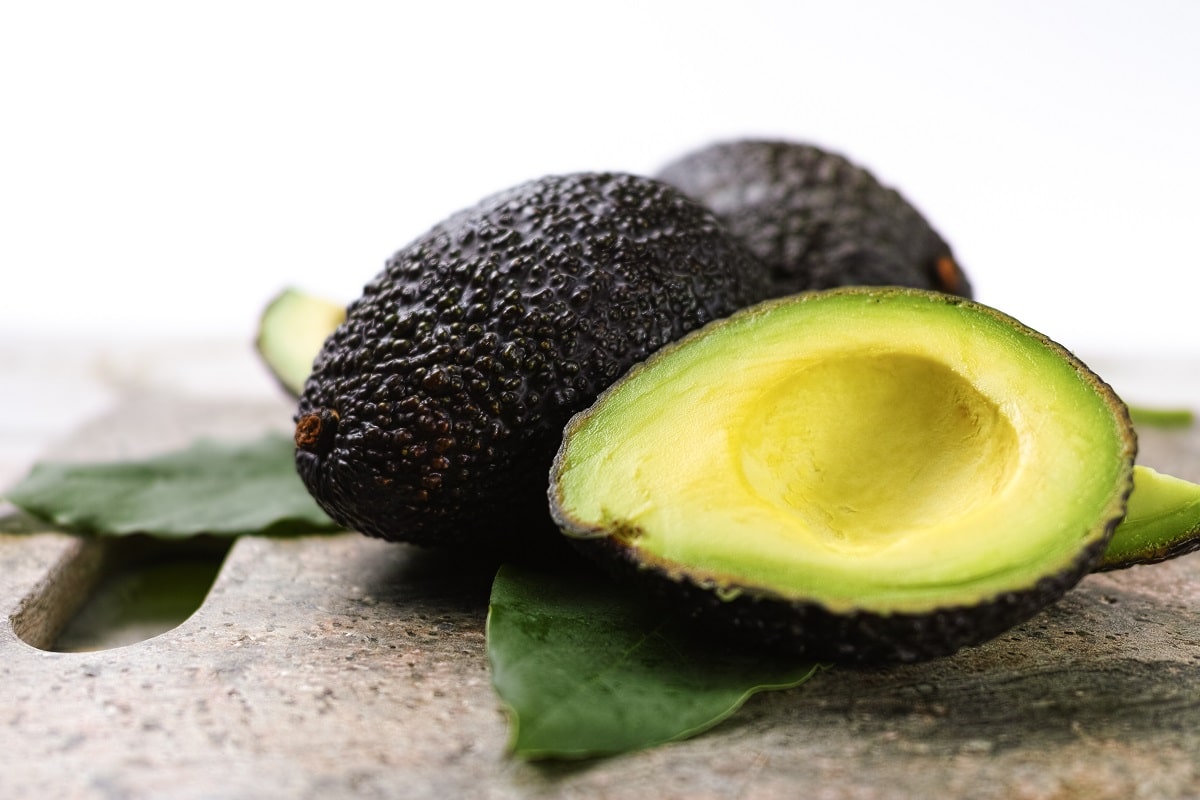
What Kind of Soil Do You Need for Growing an Avocado From Seed?
Because avocado trees have very shallow roots they are prone to root rot. Root rot happens when the roots get wet and stay wet for extended periods of time so you need soil that will drain quickly.
Loose, sandy soil is best. If you’re buying the soil already mixed look for bags that are cactus mixes. They have a similar composition to what avocados like and will work wonderfully for you.
If you want some extra protection for the roots of your trees get a container size or two bigger than you need and line the bottom with rocks. This way if water gets stuck in the tray under the tree it won’t come into contact with the roots. Which brings us to water…
Avocado Water Requirements
The number one plant killer in the home is overwatering, this goes for all plants. People who think that they need to take extra special care of their plants and give them water every day end up giving them too much water and killing them.
Basically, we kill them with love, and unfortunately, this is VERY easy to do with avocado trees. As I mentioned when talking about soil, avocado trees are prone to root rot so it’s important not to overwater them.
You won’t be able to tell if the tree needs water just by looking at it. Every few days you will need to stick your finger into the dirt and see for yourself. Here is how you test the soil to see if it needs more water.
- Stick your finger, gently, into the soil near the base of the tree, taking care not to damage the roots.
- If the dirt feels dry and crumbly the whole way down then it is time to water.
- But, if you want to take the guesswork out of the equation entirely then you should get a moisture gauge. A good one will cost you about 10 to 15 dollars and with care, it can last for years.
One way you can tell if you are overwatering or underwatering your avocado tree is by looking at the leaves.
- If the leaves of your avocado tree start turning yellow then the tree is getting too much water. Let it sit for a few days without watering it so the soil has time to dry out.
- If the tips of the leaves have started turning brown then you aren’t watering your avocado enough. Give your tree a good drink and check it more regularly.
Avocado Sun Requirements
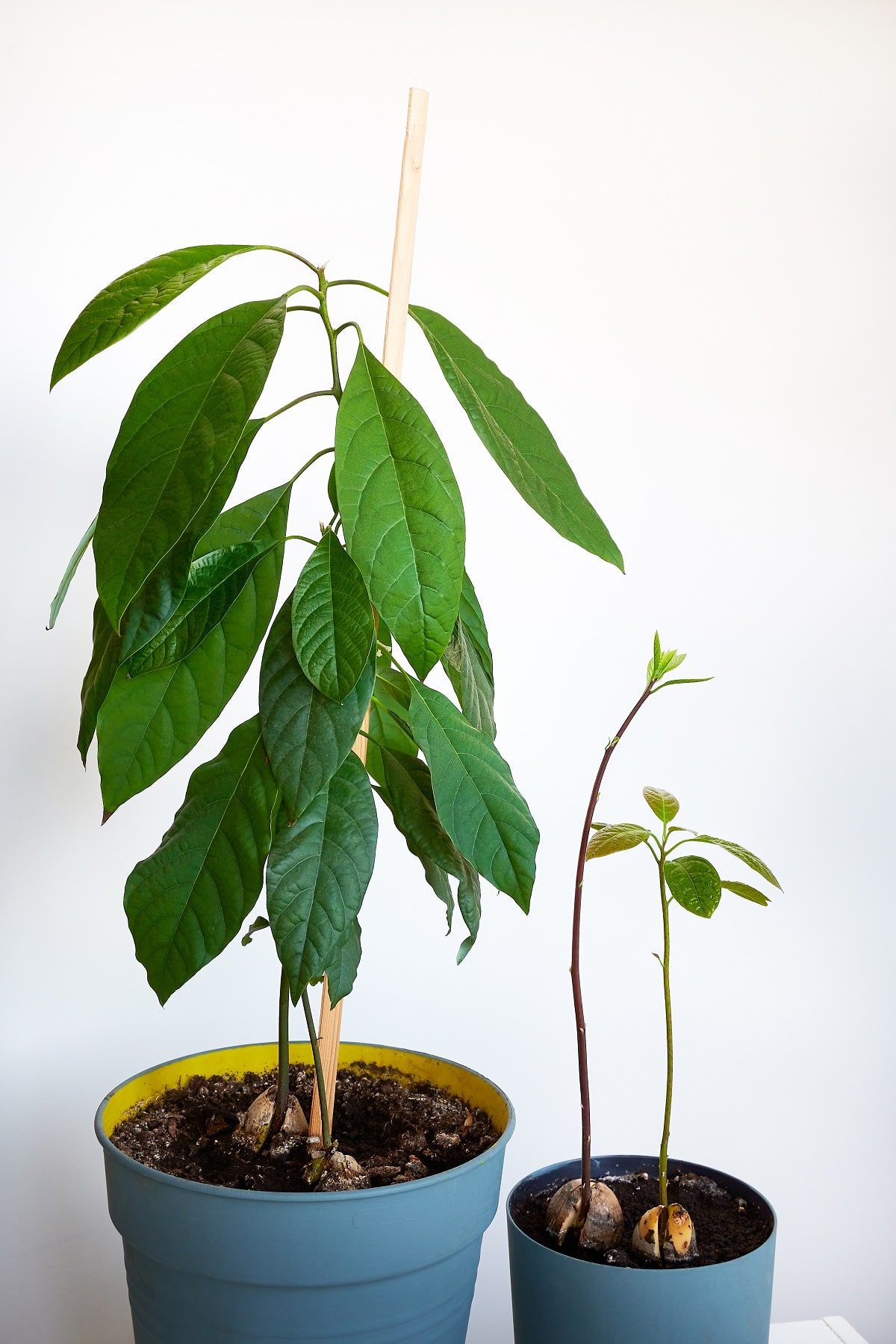
Avocado trees LOVE the sun.
You will want to give it the prime real estate in your house. A good south-facing window with long daylight hours is ideal. You might even want to supplement the sun with some grow lights just to help give it that extra little boost.
If you live somewhere that won’t dip down below 50 degrees Fahrenheit or 10 degrees Celsius in the summer then you can move your tree out to the sunniest spot in your yard. Just make sure that when the nights start getting colder you bring it back inside.
If this is something you can do then you might want to get a plant caddy with wheels. This will save your back a whole lot of aches and pains as your tree grows.
Avocado Fertilizer Needs
The good news is that you won’t have to worry about fertilizing your avocado tree the first year. In fact, they have very minimal fertilizing needs. After its first year, you only need to fertilize your avocado tree twice a year using a 10-10-10 fertilizer.
Liquid fertilizer is best and if you can afford it, then it is worth spending a little bit extra to get organic fertilizer. The first fertilizer application should be at the start of Spring as the tree is coming out of hibernation and then the second should be in mid Fall as the tree is preparing itself to go back into hibernation.
How Long Does it Take an Avocado Tree to Grow From Seed? When Will I Eat An Avocado I Grew?
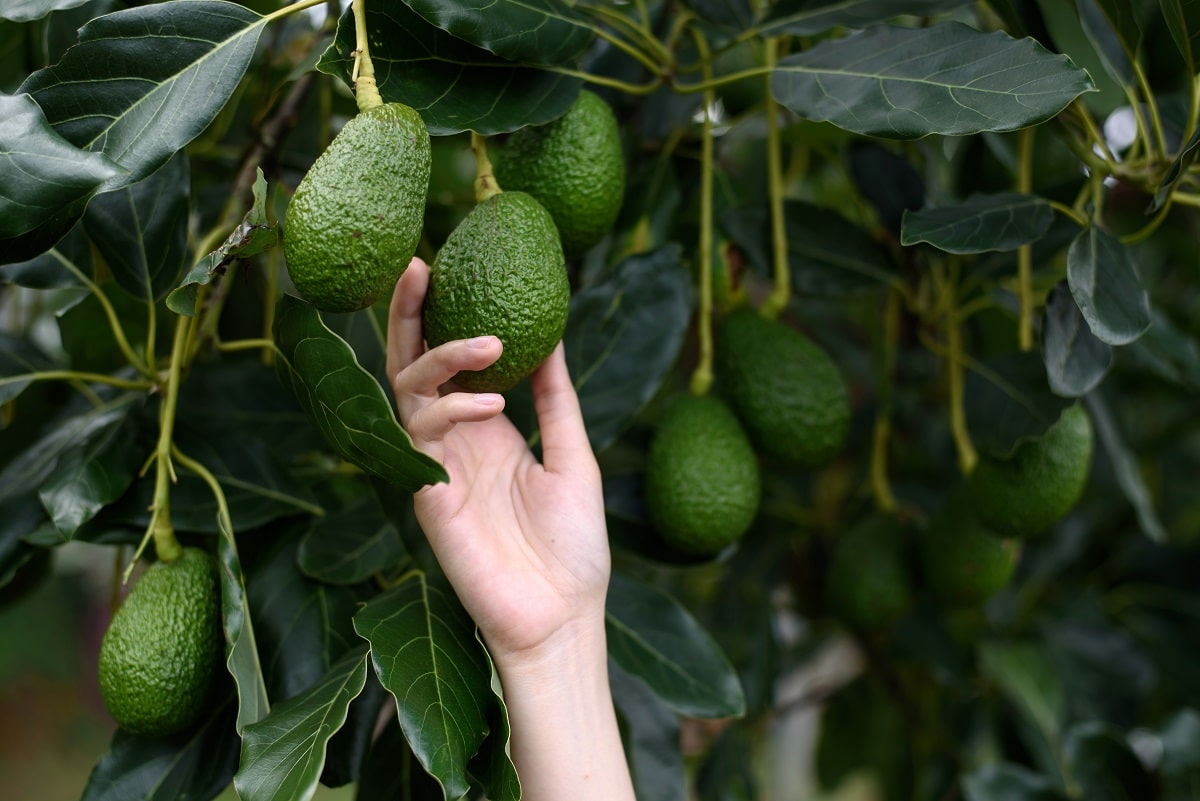
There is this saying in the gardening community, taken from an old Chinese proverb that unfortunately is very true. “The best time to plant a tree was 20 years ago. The second best time is now.” The reason for this saying is that trees take years to grow and start producing fruit.
In the case of avocado trees, you’re looking at an 8 to 20-year wait.
Yes, it takes between 8 and 20 years for an avocado tree to start producing fruit! This number can vary depending on the variety of avocado you’re growing, but, unless you hunt down a different variety you’re likely to only find one or two in your local grocery store. This is why it is so important to start growing your avocado from seed right now.
Fun Avocado Facts
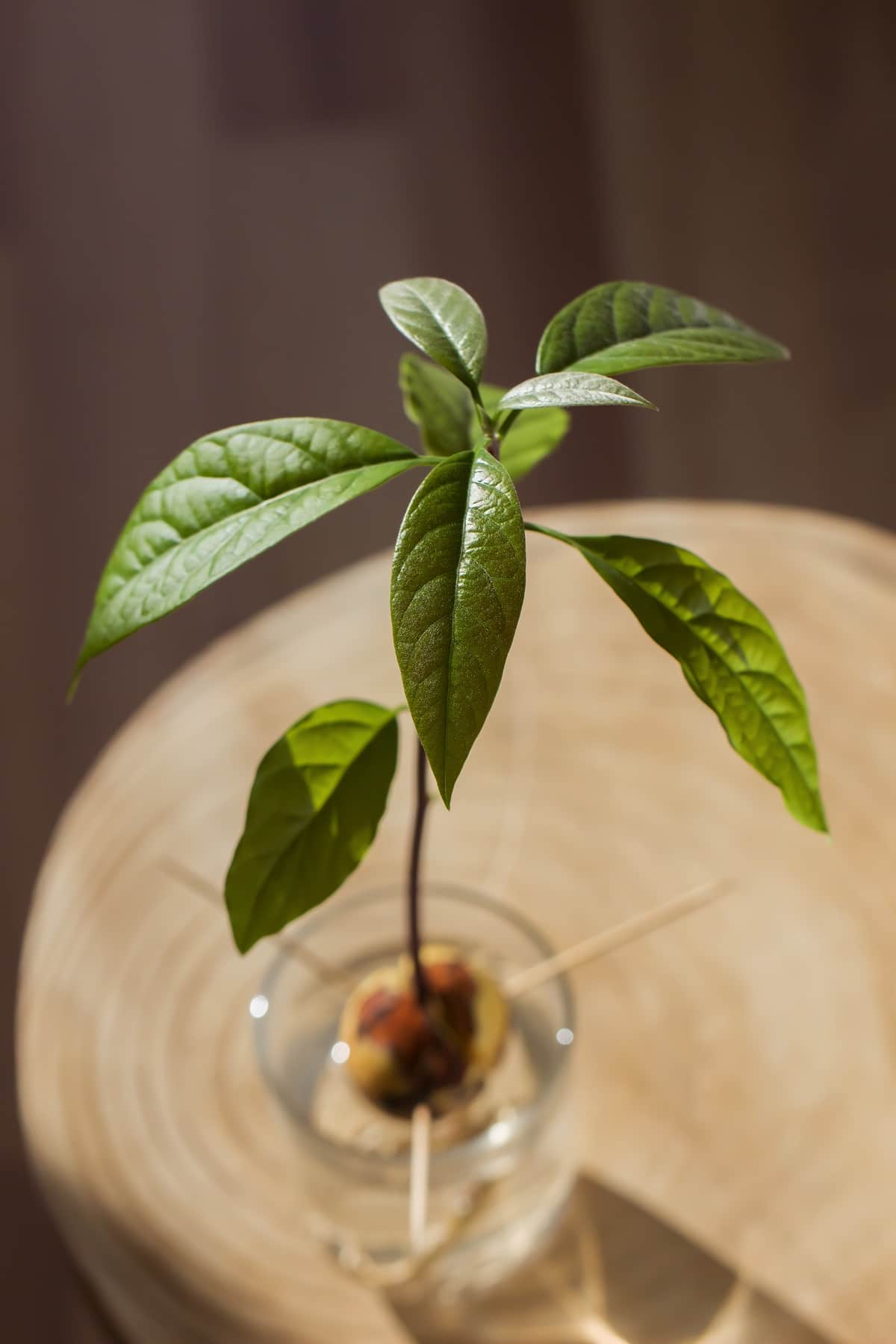
Here are a few fun avocado facts you can share with family and friends to impress them while you're growing your avocado from seed.
- Avocados have more potassium than bananas, nearly double in fact!
- The name ‘avocado’ originated from the Aztec word ‘ahuacatl,’ which means ‘testicle.’
- Avocados are fruit, in fact, botanically speaking they are berries and in some parts of the world, they are eaten like a fruit.
- Avocados are related to Cinnamon.
- There are more than 500 varieties of avocado plant in the world. But most stores only stock two.
- Avocados can become seedless under the right conditions. But why would you want to do that? Then you couldn’t grow them from seed!
- Tom Selleck and Jamie Foxx are avocado farmers.
- Avocado fruit evolved to be eaten whole by giant mammals like the giant ground sloth. It is only thanks to Humans enjoying them that this delicious fruit has survived to modern-day.

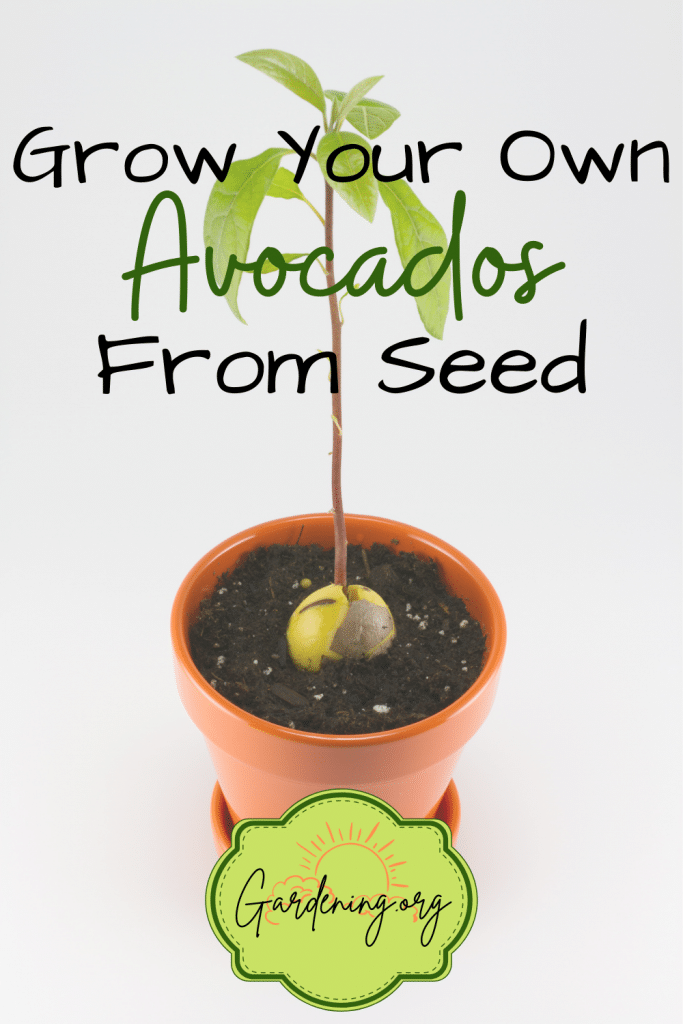

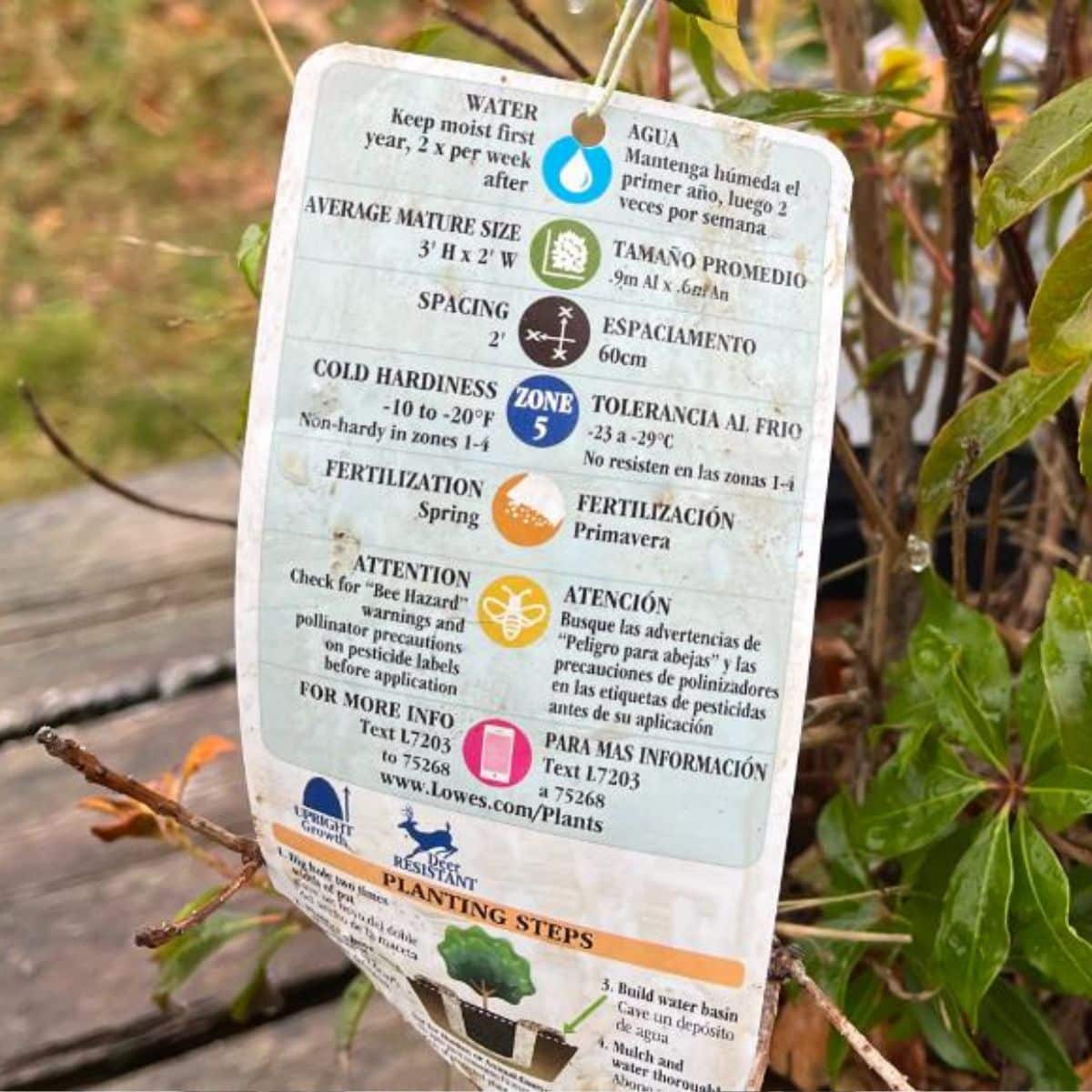

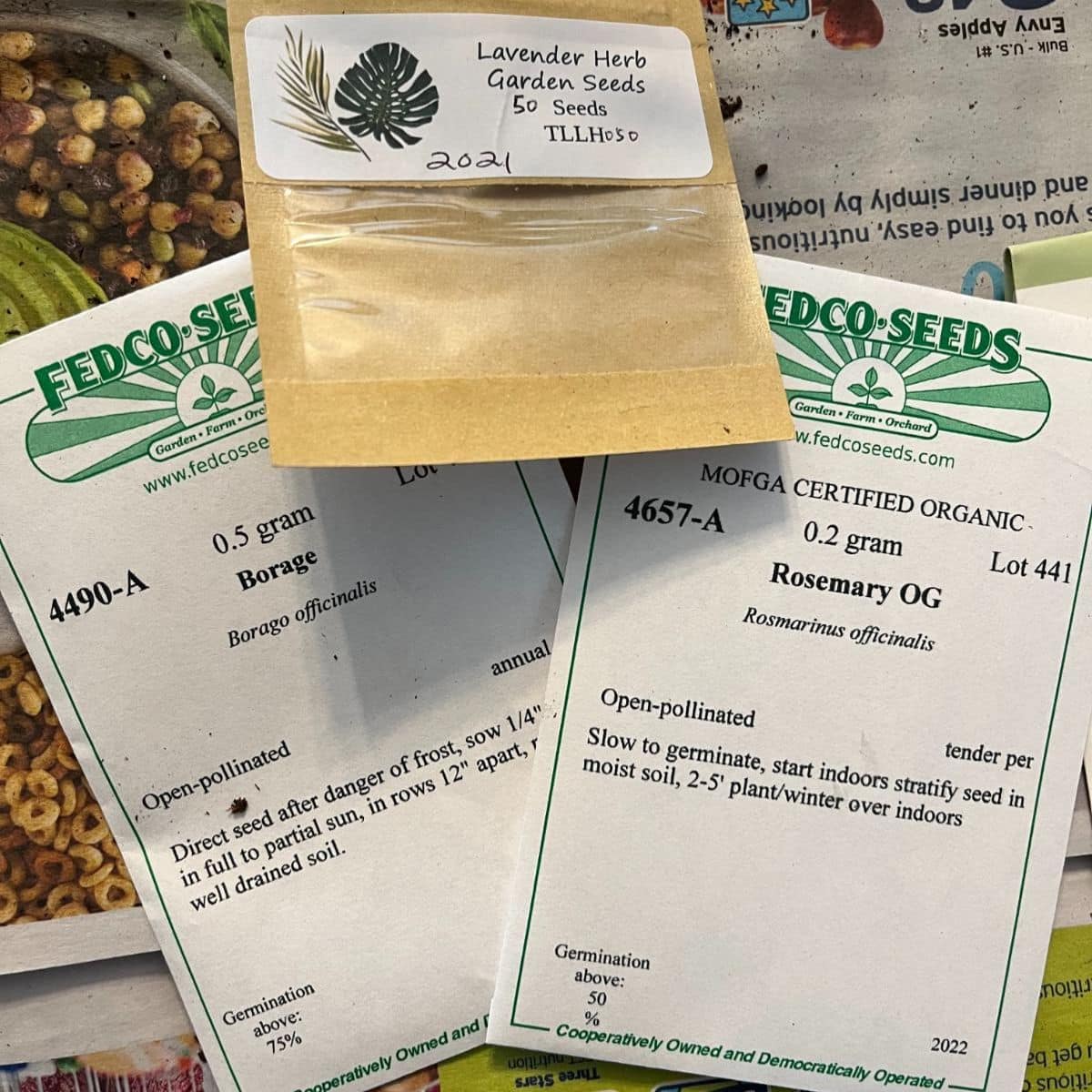
MichelleDube
Outstanding Presentation.
MichelleDube
Thank you: again, thank you
Michelle
This was very informative however I just grew my very first Avocado tree using the toothpick method. It was easy, and hassle free.
The roots started first then within 2-3 days I had a tree sprout and it took off from there. So now I have another 20 years to see if it produces an avocado 🙂
Andrea
I have only ever used the toothpick method to grow avocado plants from seed, and I have never had any problems. It is the method recommended by the California Avocado Commission. My son and I grew a plant to 5 feet using this method, and hopefully it is still growing in the care of the people we gave it to when we moved across the country!
Kim Meadows
Great information! Question....how do we know when it's time to transfer it to a bigger pot? The stem is currently 23 inches tall with about ten small leaves. Should it be replanted with the pit still on the surface of the soil? Thanks so much!
Mary Ward
It is recommended that you repot your avocado once a year for the first three years, then once every two or three years after that--or whenever you notice it is becoming root-bound. Pot up to a pot about three inches larger in diameter than the pot it is in. Plant it at the same level it was planted before, so, yes, with some pit showing. Spring is the best time for pruning and repotting, but if the plant is bound or not thriving, don't worry about what time of year it is.
Pedrito
Just put the pit on dirt and it'll grow fine, done it many times
Mary Ward
As long as you live somewhere warm enough! In northern areas you'll need to pot the seed so it can be moved indoors during winter.